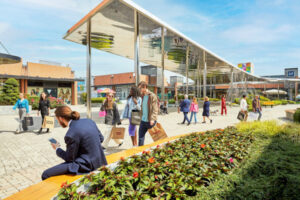With a transaction volume of around €9.2 billion, the investment market for retail real estate has heated up rapidly when compared to the first half of last year (H1 2014: €4.8 billion). The volume has almost doubled following a strong second quarter. This was mainly due to the resale of 43 department stores as part of the corporate takeover of Kaufhof by Hudson’s Bay and the sale of several shopping centers. The volume grew to more than €6.2 billion from April to June. That’s twice as much as in the first quarter of 2015. It’s also the best quarterly result in almost 10 years – since the first quarter of 2006. JLL now expects a total volume of around €15 billion for the full year.
The lion’s share of the transaction volume (€2.3 billion) in the second quarter is attributable to the country’s seven largest cities. Together, these account for more than a quarter of the total volume. The capital, Berlin, leads with around €1 billion, followed by Munich (€400 million) and Dusseldorf (€250 million). Shopping centers are the highest-volume asset class. Department stores followed in second place, ahead of supermarkets and department stores. The proportion of foreign players among the buyers and sellers has also risen considerably.
Jörg Ritter, a member of the German Management Board at JLL: “Retail properties again significantly expanded their share in the total commercial transaction volume during the first half of the year. At 39%, they have even overtaken the office market by one percentage point. One reason for the strong improvement was the outstanding turnover in the department store business, enlivened by the sale of 43 Kaufhof stores. Along with Klépierre’s acquisition of Corio in the first quarter, the unusually high volumes in the first half were due largely to two major transactions. This is clearly also due to investors’ continued confidence in commercial real estate for retail use.”
Shopping centers: Volume almost tripled compared to last year
Shopping centers made up around 34% (almost €3.1 billion) of the total transaction volume in the first half. That’s almost triple the figure for the same period in the previous year (€1.19 billion). The driving force here was Corio’s acquisition of the French center operator Klépierre.
After a weak start to the year, with only around €47 million in transactions, department stores made an impressive comeback and closed the first half with a transaction volume of nearly €2.6 billion. JLL’s forecast upward trend after the first quarter thus materialized. The decisive factor was the resale of 43 department stores as part of Kaufhof’s corporate takeover by Hudson’s Bay. At the same time, there are grounds for further optimism: The demand for properties in good locations remains high, but it depends to a large extent on the availability of appropriate real estate.
Bog box products: Big box stores are suffering from supply shortages
The figures for big box stores do not currently reflect the market’s potential. Sellers are very reluctant due to the current interest rate situation. Supply is therefore scarce. Nevertheless, big box stores are still the third-largest asset class, at €2.31 billion (25% of the total). The same period last year, however, saw slightly better performance, with €2.57 billion in volumes, making it the only category to show a decline in the first half of this year.
In the subcategories, supermarkets showed the highest volumes, at €1.2 billion, exceeding the number for the same period last year (€898 million) by about a quarter. The reason: Multiple supermarket portfolios represented four of the five largest retail transactions in the first quarter. Among retail parks, however, the supply shortage continued. The previous year’s figure of more than €1 billion couldn’t be sustained, despite strong demand. The volume came in at just €751 million. Big box stores themselves saw a significant decline, from €664 million to €344 million.
Retail buildings in prime urban locations cemented their reputation as a favorite of many investors. With a transaction volume of €1.27 billion in the first half of 2015, the segment picked up markedly and closed at a level more than double that of the previous year (€562 million Euros). The significant increase in the first quarter was confirmed in the second, continuing to grow at a constant rate. Despite the great growth, there is still considerable potential for improvement even here. The reason: This value masks the actual demand for such real estate, which is significantly higher. Once again, despite the upward trend, a lack of suitable properties for sale continues.
Foreign investors dominate market
Foreign investors significantly expanded their share of the transactions in the German market compared to last year. Foreign investors were on the buying side of all four of the largest deals and were involved in seven of the top 10 transactions. The concrete figures make this even clearer: Foreign players stood on the buying side for 71% of the total transaction volume. It had still been just 48% the previous year. On the selling side, too, their share rose again to 77%. The six largest transactions were are all made by foreign sellers. On balance, the stock of German retail properties owned by foreigners fell by €500 million in the first half.
Due to strong demand for retail real estate, prime yields remain low. That for shopping centers currently stands at 4.4%. JLL estimates that for retail parks at 5.5% and for individual big box stores at 5.8%. Department stores reach, from an average of prime yields in the seven largest cities, just under 3.92%. Munich has lowest rate here, at just 3.5%.





